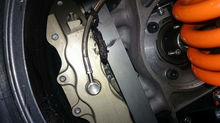Fuel Systems
- Alex Harrington
- Oct 22, 2015
- 2 min read
Todays’ lesson was a fun lesson in that we were tasked with designing a fuel system for a Norma CN group endurance car, the regulations state that the car cannot race with any more than 80L of fuel on board.
We were given the basic dimensions of the area for the fuel cell to fit into behind the seat bulkhead, we found that with the dimensions we had been given and the thickness of the cell material we would only have approximately 75 litres of fuel without an in tank pump. We then changed the dimensions on the bottom width of the cell to 429mm, this allowed us to have 81.32L of fuel without the pump. The driver would have to sit lower down in the car as a result of the cell size change but this would be good for aerodynamics and would mean we could run the car as
close to the maximum of 80 litres of fuel as possible.
To calculate the exact size we would have to increase the cell by we found a fuel pump that we would have in the cell and calculated the volume that the pump would take up and subtracted this from the overall volume which brought it down to 80.82L so we will use 3 capacity reducing balls from demon tweeks, 1x 0.52L and 2x 0.18L this all combined will bring the volume of fuel down to 79.94L of fuel.
When fuelling the car it will be nearly impossible to put exactly 79.94L of fuel in so we can round down to just 79L to put in the car but if we can electronically control the pump to be able to put an exact amount of fuel in then we will be able to put the precise amount of fuel in that might get us through an extra sector of track and also will allow for spillage, time sat on the grid in idle and will mean that we can offer teams a larger amount of fuel than they may be already using so this will encourage people to buy out system over the one they are currently using.
The cost of the system so far for the pump and capacity reducing balls is £165.16. We will be using a Bosch 044 high performance fuel injection pump from demon tweeks, this pump can run at a maximum pressure of 11 bar (154Psi) and has a flow rate of 264 litres per hour when it is running at 3 bar, this is an acceptable pump for the engine it will be fuelling ( 2L K20 Honda engine).
This is as far as we got in this lesson but we will carry on with this in our own time and in next lesson.
Below is a photo of my notes and calculations from the lesson*.


As you can see this project is not finnished, we are hopefully going to complete it within the next few weeks. When the project is finnished i will post the rest of the notes and schematics here on my blog.
*These notes are only rough workings.















Comments